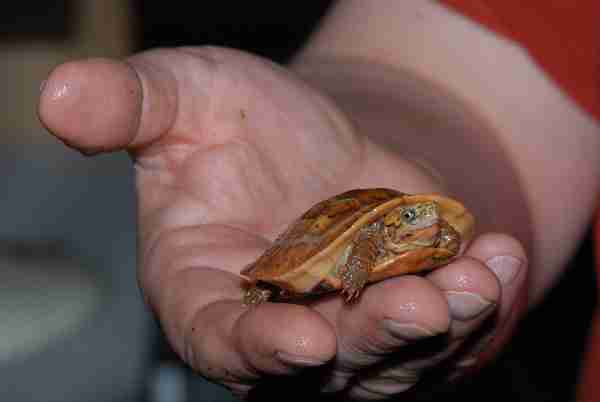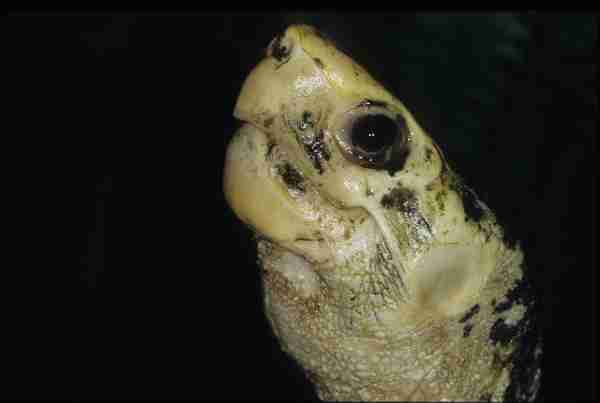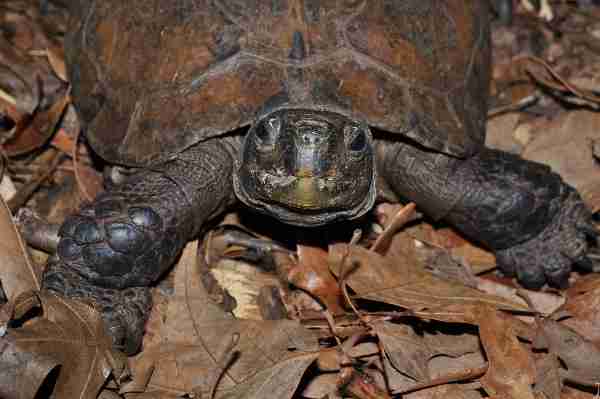Dr Martina Raffel and Elmar Meier
Allwetterzoo Münster, Sentruper Straße 315, 48161 Münster, Germany.
E-mail: raffel{at}allwetterzoo.de
In a previous report we gave an introduction to the International Centre for the Conservation of Turtles (IZS) in Münster Zoo and the background of the project (Meier & Raffel, 2007). Since that time, a lot of offspring have hatched and additional activities have been started.
The joint project by Münster Zoo, the Zoological Society for the Conservation of Species and Populations (ZGAP) and the German Herpetological Society (DGHT) currently houses 278 specimens in 20 species and 24 subspecies (two of these not being acknowledged internationally). The focus is on the box turtles of the genus Cuora, with unrivalled breeding successes. About 120 specimens of the critically endangered yellow-headed box turtle (Cuora aurocapitata), McCord’s box turtle (Cuora mccordi), the golden coin box turtle (Cuora trifasciata sensu lato) and Zhou’s box turtle (Cuora zhoui) are kept in the breeding centre. An additional 40 offspring of these four species have already been transferred into other institutions.
Four species and two hybrid forms have been taken out of the project: the Malaysian black mud turtle (Siebenrockiella crassicollis), the Chinese pond turtle (Chinemys reevesii), the Chinese broad-headed pond turtle (Chinemys megalocephala) and the spotted pond turtle (Geoclemys hamiltoni) as well as the hybrid forms Mauremys ‘iversoni’ and Mauremys ‘pritchardi’ which had to be removed in the course of the determination of focus species. On the other hand, Beal’s eyed turtle (Sacalia bealei) and the tricarinate hill turtle (Melanochelys tricarinata) were added to the project – the first due to a private donation, the second after specimens had been confiscated at Frankfurt Airport and given to IZS on loan from Frankfurt Zoo (or rather the Federal Agency for Nature Conservation as the actual owner). Further reduction of species and a focus on critically endangered species are planned and necessary due to space limitation.
Up to now, a total of 243 specimens have hatched since the start of operation in 2003 (see Table 1): 5 in 2004, 14 in 2005, 78 in 2006, 61 in 2007, 49 in 2008 and 36 in 2009, while eggs of Chinemys nigricans and Mauremys annamensis were no longer or only partly incubated due to lack of interest from other institutions. Unfortunately, repair and maintenance of the enclosures and the associated evacuation of the turtles led to a considerable disturbance of the breeding efforts in 2008, thus resulting in lower offspring numbers in 2008 and 2009. In the end, however, the breeding success is mainly restricted by the available spare time of the co-author as the main carer after work and at weekends, along with his wife and a few friends.
| No. of hatchlings | Scientific name | Common name | Comment |
|---|
| 11 | Chelodina mccordi | McCord’s box turtle | 5 died |
13
| Chinemys megalocephala | Chinese broad-headed pond turtle | |
33
| Chinemys nigricans | Red-necked pond turtle | Eggs have not been incubated in 2008 and 2009 |
1
| Chinemys reevesii
| Chinese pond turtle
| |
29
| Cuora aurocapitata | Yellow-headed box turtle | |
14
| Cuora cyclornata ssp. | Golden coin box turtle (Southern N. Vietnamese turtle)
| |
4
| Cuora cyclornata meieri
| Meier’s golden coin box turtle (Northern Vietnamese form)
| |
6
| Cuora flavomarginata evelynae | Ryukyu yellow-margined box turtle | |
2
| Cuora (galbinifrons)
| Bourett’s box turtle | |
1
| Cuora (galbinifrons) galbinifrons | Vietnamese box turtle | First successful breeding in a European Zoo (EAZA Shellshock Captive Breeding Award) |
| 31 | Cuora mccordi | McCord’s box turtle | |
| 16 | Cuora trifasciata | Golden coin box turtle (Southern Chinese form) | |
| 21 | Cuora zhoui | Zhou’s box turtle | |
| 1 | Heosemys depressa | Arakan forest turtle | Died shortly after hatching |
| 5 | Leucocephalon yuwonoi | Sulawesi forest turtle | 2 died |
| 41 | Mauremys annamensis | Annam leaf turtle | Eggs have only been partly incubated in 2008 and 2009 |
| 13 | 'Mauremys pritchardi' | Hybrid Mauremys mutica x Chinemys reevesii | Hybrid form (removed in 2008) |
| 1 | 'Mauremys iversoni' | Hybrid Mauremys mutica x Cuora trifasciata | Hybrid form (removed in 2008) |
| 243 | Total
| | |
Besides regular successful breeding of the four above mentioned critically endangered box turtles in the past years, there are additional first breeding successes to be mentioned in particular: in 2007, the Meier‘s golden coin box turtle (Cuora cyclornata meieri), and in 2008 Bourett’s box turtle (Cuora galbinifrons bouretti) (Figs 1-2). The former has been separated from the golden coin box turtle (Cuora trifasciatata) only in 2006 and now bears its name in the co-author’s honour (Blanck et al., 2006). A probable additional subspecies of the Vietnamese golden coin box turtle (Cuora cyclornata ssp.) which occurs in the southern parts of Northern Vietnam was also bred successfully. Likewise in 2008, the first surviving offspring of the Sulawesi forest turtle (Leucocephalon yuwonoi) hatched, the first ever in Europe (Figs 3-4). After two specimens had hatched the year before, but did not survive, the breakthrough in this species now seems to have been managed, with currently three hatchlings growing in the breeding centre. Thus only the breeding of the Arakan forest turtle (Heosemys depressa) (Fig. 5) still poses a problem, as egg deposition and hatching have occurred so far, but the young died shortly thereafter. Obviously the nutrition of the females still needs to be optimized in order to provide sufficient nutrients to the young in the first critical phase.
An international network of breeding colonies has started to be established, with surplus wild-caught specimens and offspring from IZS having been transferred into other institutions. Zoos interested in the husbandry of the species are considered preferentially, but also rescue stations and very experienced private breeders may obtain turtles with the conclusion of a breeding loan contract. Up to now, 115 specimens in nine species – more than 90% of which had been bred in the IZS – have been given on loan to ten zoos, two rescue and breeding centres and sixteen private breeders in nine European countries. Further interest comes from Vietnam and China and the first transfer of two McCord’s box turtles to the USA is close at hand.
In addition to the establishment of assurance colonies in captivity sharing knowledge of the biology and reproduction of the managed species has top priority. This was also the aim of the 2nd International Chelonian Congress at Münster Zoo which took place in April 2010 and attracted chelonian experts from all over the world, including several Chinese participants.

Fig. 1. Hatchling of Meier’s golden coin box turtle (Cuora cyclornata meieri). Photo by Hans-Dieter Philippen.
Fig. 2. Hatchling of Bourett’s box turtle (Cuora galbinifrons bouretti). Photo by Hans-Dieter Philippen.
Fig. 3. Portrait of a Sulawesi forest turtle (Leucocephalon yuwonoi). Photo by Roland Wirth.
Fig. 4. Hatchling of the Sulawesi forest turtle (Leucocephalon yuwonoi). Photo by Hans-Dieter Philippen.
Fig. 5. Portrait of an Arakan forest turtle (Heosemys depressa). Photo by Roland Wirth.
Field surveys in China
In cooperation with the Senckenberg Zoological Museum, Dresden, Münster Zoo started its first field work in China in 2007 and 2008 to relocate potential relict populations of box turtles in situ and trigger protection measures and conservation work in the natural habitat. The required funding had been largely attracted from the EAZA ShellShock Campaign. Altogether, researcher Markus Auer travelled for 14 weeks in China and collected all available information regarding former and present distribution of the box turtles as well as ecological aspects from hardly accessible Chinese scientific publications and scientific collections or scientists, turtle breeders and traders. With the exception of Zhou’s box turtle, which is supposed to live in Vietnam and Laos, evidence for the occurrence of all species in China could be provided. The situation in the wild, however, was assessed as dramatic as feared: four of the six focus species are on the brink of extinction or (almost) extinct in the wild. For each species all information as well as photos of the turtles and their habitats were collected. The resulting recommended procedures were included in a final report.
Genetic research
The genus Cuora is known to exhibit more phenotypic diversity than previously assumed, leading to numerous taxonomic controversies within the last two centuries (e.g. Blanck et al., 2006; Spinks & Shaffer, 2007). Modern molecular genetic analyses so far have led to even more confusion and controversy about the phylogenetic structure in this genus. In the early 2000s, mitochondrial DNA (mtDNA) was thought to perfectly reflect the taxonomic relationship of species (e.g. Stuart & Parham 2004; Spinks et al., 2004). The proof of many hybrid turtles appearing in the Chinese trade, some of them described as new species, questioned this view again, as mtDNA is only suitable for identifying maternal lines. Since 2006, nuclear DNA (nDNA) has been considered to provide better insights into the phylogenetic and taxonomic relationships and the validity of several varieties/subspecies/species. The validity of a species is of the utmost importance for conservation projects and also has a substantial impact on the implementation of conservation legislature. Moreover, detecting hybrids allows allocating resources in a reasonable manner, so as not to waste time and money for the breeding of hybrids not relevant for conservation. Detecting genetic structure along geographic distance (potentially leading to the delineation of subspecies) is especially important to form ‘pure blood lines’ in captive breeding programmes for potential future reintroduction projects. In this context, an analytical framework in which captive zoo-bred turtles can be assigned to natural populations of origin needs to be developed.
First DNA research started in 2007 and 2008 on several captive EAZA Cuora trifasciata specimens and resulted in a restart of the European Studbook Foundation studbook, managed by Torsten Blanck and the co-author. In 2009, the IZS initiated with several partners a broader nDNA research in the genus Cuora to be carried out by the Universities of Potsdam and Hamburg in Germany. A respective proposal was jointly elaborated and sent to several grant-making organizations, amongst them the British Chelonia Group who approved funding to this project. In the first part of the project, we will elaborate on our previous efforts to sequence several mitochondrial genetic markers so as to provide a thorough phylogenetic framework of the genus Cuora. Secondly, we will use analysis of nuclear DNA polymorphisms using microsatellite fragment length variation, which offers several advantages: (a) due to the high degree of polymorphism seen at microsatellite loci, genetic structure can be resolved where standard sequence markers may fail to detect variation (e.g. to delineate sub-species); (b) potential hybrids between species or subspecies can be detected; and (c) parental lineages can be detected to form definitely pure breeding groups. Respective blood and tissue samples for molecular analyses have been provided by the collaborating institutions and private breeders, and laboratory work to detect microsatellites has started. The results will help to establish ‘pure’ breeding groups and give transfer recommendations accordingly.
We want to thank the British Chelonia Group sincerely for their continuing support.
References
Blanck, T., McCord, W.P. & Le, M. (2006). On the variability of Cuora trifasciata (BELL, 1825). Frankfurter Beiträge zur Naturkunde, Band 31, 153 pp.
Meier, E. & Raffel, M. (2007). The International Centre for the Conservation of Turtles in Münster Zoo – an Ark for the last Individuals of several Species. B.C.G. Testudo 6(4): 74-85.
Spinks, P.Q., Shaffer, H.B., Iverson, J.B. & McCord, W.P. (2004). Phylogenetic hypotheses for the turtle family Geoemydidae. Molecular Phylogenetics and Evolution 32: 164-182.
Spinks, P.Q. & Shaffer, H.B. (2007). Conservation phylogenetics of the Asian box turtles (Geoemydidae, Cuora): mitochondrial introgression, numts, and inferences from multiple nuclear loci. Conservation Genetics 8: 641-657.
Stuart, B.L. & Parham, J.F. (2004). Molecular phylogeny of the critically endangered Indochinese box turtle (Cuora galbinifrons). Molecular Phylogenetics and Evolution 31: 164-177.
Appendix – species kept but not currently breeding
Cuora amboinensis ssp. (Philippine form of the South Asian box turtle)
Cuora cyclornata ssp. (Central Vietnamese form)
Cuora (galbinifrons) picturata (Southern Vietnam box turtle)
Cuora pani (Pan’s box turtle)
Melanochelys tricarinata (Tricarinate hill turtle)
Notochelys platynota (Malayan flat-shelled turtle)
Ocadia sinensis (Chinese stripe-necked turtle)
Sacalia bealei (Beal’s eyed turtle)
Sacalia quadriocellata (Four-eyed turtle)
Testudo Volume Seven Number Two 2010
Top





